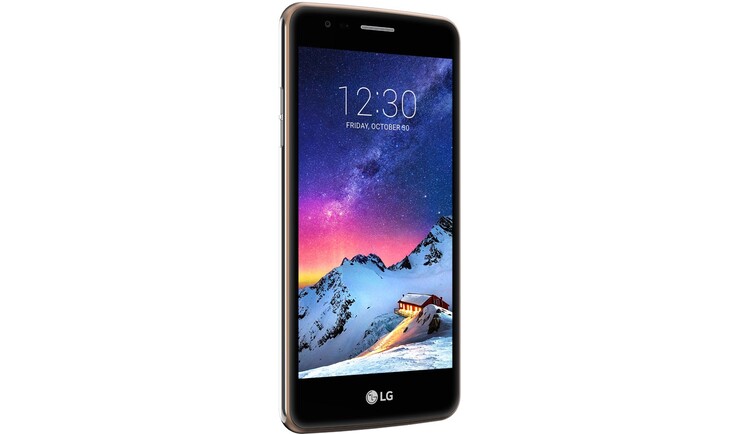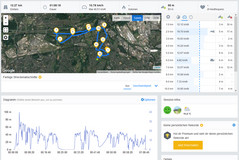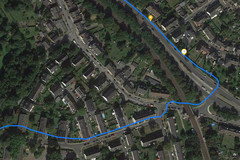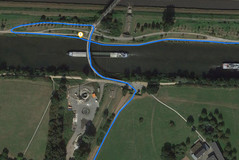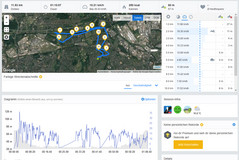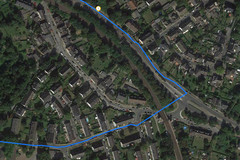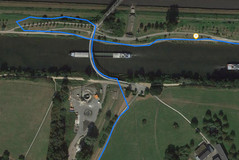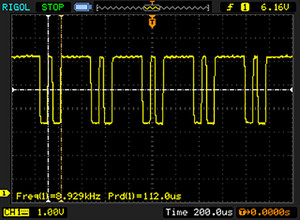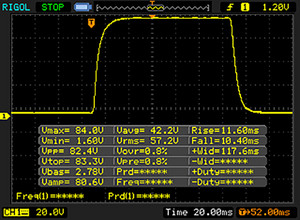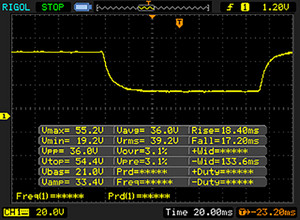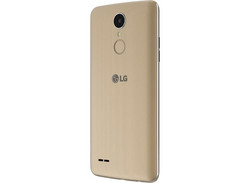LG K8 (2017) 智能手机简短评测
» Notebookcheck多媒体笔记本电脑Top 10排名
» Notebookcheck游戏笔记本电脑Top 10排名
» Notebookcheck低价办公/商务笔记本电脑Top 10排名
» Notebookcheck高端办公/商务笔记本电脑Top 10排名
» Notebookcheck工作站笔记本电脑Top 10排名
» Notebookcheck亚笔记本电脑Top 10排名
» Notebookcheck超级本产品Top 10排名
» Notebookcheck变形本产品Top 10排名
» Notebookcheck平板电脑Top 10排名
» Notebookcheck智能手机Top 10排名
» Notebookcheck评测过最出色的笔记本电脑屏幕
» Notebookcheck售价500欧元以下笔记本电脑Top 10排名
» Notebookcheck售价300欧元以下笔记本电脑Top 10排名
| Networking | |
| iperf3 transmit AX12 | |
| Asus Zenfone Go ZB500KL | |
| LG K10 2017 | |
| Lenovo K6 | |
| LG K8 2017 | |
| Gigaset GS160 | |
| iperf3 receive AX12 | |
| Asus Zenfone Go ZB500KL | |
| LG K8 2017 | |
| Lenovo K6 | |
| LG K10 2017 | |
| Gigaset GS160 | |
| |||||||||||||||||||||||||
Brightness Distribution: 93 %
Center on Battery: 358 cd/m²
Contrast: 731:1 (Black: 0.49 cd/m²)
ΔE ColorChecker Calman: 7.1 | ∀{0.5-29.43 Ø4.78}
ΔE Greyscale Calman: 6.5 | ∀{0.09-98 Ø5}
Gamma: 2.12
CCT: 8166 K
| LG K8 2017 IPS, 1280x720, 5" | LG K10 2017 IPS, 1280x720, 5.3" | Huawei Y6 II Compact IPS, 1280x720, 5" | Asus Zenfone Go ZB500KL IPS, 1280x720, 5" | Gigaset GS160 IPS, 1280x720, 5" | Lenovo K6 IPS, 1920x1080, 5" | |
|---|---|---|---|---|---|---|
| Screen | 13% | 1% | 22% | 5% | 28% | |
| Brightness middle (cd/m²) | 358 | 384 7% | 491 37% | 459 28% | 489 37% | 470 31% |
| Brightness (cd/m²) | 351 | 350 0% | 487 39% | 452 29% | 479 36% | 461 31% |
| Brightness Distribution (%) | 93 | 85 -9% | 92 -1% | 84 -10% | 95 2% | 88 -5% |
| Black Level * (cd/m²) | 0.49 | 0.36 27% | 0.9 -84% | 0.42 14% | 0.55 -12% | 0.38 22% |
| Contrast (:1) | 731 | 1067 46% | 546 -25% | 1093 50% | 889 22% | 1237 69% |
| Colorchecker dE 2000 * | 7.1 | 6 15% | 6.6 7% | 4.5 37% | 8.3 -17% | 5.2 27% |
| Colorchecker dE 2000 max. * | 14.9 | 14 6% | 12.9 13% | 10.6 29% | 14.4 3% | 9.5 36% |
| Greyscale dE 2000 * | 6.5 | 5.9 9% | 4.9 25% | 6.5 -0% | 8.7 -34% | 5.6 14% |
| Gamma | 2.12 104% | 2 110% | 2.12 104% | 2.22 99% | 2.08 106% | 2.24 98% |
| CCT | 8166 80% | 8042 81% | 7090 92% | 7791 83% | 9034 72% | 7924 82% |
* ... smaller is better
Screen Flickering / PWM (Pulse-Width Modulation)
| Screen flickering / PWM detected | 8929 Hz | ≤ 25 % brightness setting | |
The display backlight flickers at 8929 Hz (worst case, e.g., utilizing PWM) Flickering detected at a brightness setting of 25 % and below. There should be no flickering or PWM above this brightness setting. The frequency of 8929 Hz is quite high, so most users sensitive to PWM should not notice any flickering. In comparison: 53 % of all tested devices do not use PWM to dim the display. If PWM was detected, an average of 8091 (minimum: 5 - maximum: 343500) Hz was measured. | |||
Display Response Times
| ↔ Response Time Black to White | ||
|---|---|---|
| 22 ms ... rise ↗ and fall ↘ combined | ↗ 11.6 ms rise | |
| ↘ 10.4 ms fall | ||
| The screen shows good response rates in our tests, but may be too slow for competitive gamers. In comparison, all tested devices range from 0.1 (minimum) to 240 (maximum) ms. » 47 % of all devices are better. This means that the measured response time is similar to the average of all tested devices (20.2 ms). | ||
| ↔ Response Time 50% Grey to 80% Grey | ||
| 35.6 ms ... rise ↗ and fall ↘ combined | ↗ 18.4 ms rise | |
| ↘ 17.2 ms fall | ||
| The screen shows slow response rates in our tests and will be unsatisfactory for gamers. In comparison, all tested devices range from 0.165 (minimum) to 636 (maximum) ms. » 49 % of all devices are better. This means that the measured response time is worse than the average of all tested devices (31.6 ms). | ||
| AnTuTu v6 - Total Score (sort by value) | |
| LG K8 2017 | |
| LG K10 2017 | |
| Huawei Y6 II Compact | |
| Asus Zenfone Go ZB500KL | |
| Gigaset GS160 | |
| Lenovo K6 | |
| 3DMark | |
| 1280x720 offscreen Ice Storm Unlimited Score (sort by value) | |
| LG K8 2017 | |
| LG K10 2017 | |
| Huawei Y6 II Compact | |
| Asus Zenfone Go ZB500KL | |
| Gigaset GS160 | |
| Lenovo K6 | |
| 1280x720 offscreen Ice Storm Unlimited Graphics Score (sort by value) | |
| LG K8 2017 | |
| LG K10 2017 | |
| Huawei Y6 II Compact | |
| Asus Zenfone Go ZB500KL | |
| Gigaset GS160 | |
| Lenovo K6 | |
| 1280x720 offscreen Ice Storm Unlimited Physics (sort by value) | |
| LG K8 2017 | |
| LG K10 2017 | |
| Huawei Y6 II Compact | |
| Asus Zenfone Go ZB500KL | |
| Gigaset GS160 | |
| Lenovo K6 | |
| 2560x1440 Sling Shot OpenGL ES 3.0 (sort by value) | |
| LG K8 2017 | |
| LG K10 2017 | |
| Huawei Y6 II Compact | |
| Asus Zenfone Go ZB500KL | |
| Lenovo K6 | |
| 2560x1440 Sling Shot OpenGL ES 3.0 Graphics (sort by value) | |
| LG K8 2017 | |
| LG K10 2017 | |
| Huawei Y6 II Compact | |
| Asus Zenfone Go ZB500KL | |
| Lenovo K6 | |
| 2560x1440 Sling Shot OpenGL ES 3.0 Physics (sort by value) | |
| LG K8 2017 | |
| LG K10 2017 | |
| Huawei Y6 II Compact | |
| Asus Zenfone Go ZB500KL | |
| Lenovo K6 | |
| GFXBench (DX / GLBenchmark) 2.7 | |
| T-Rex Onscreen (sort by value) | |
| LG K8 2017 | |
| LG K10 2017 | |
| Huawei Y6 II Compact | |
| Asus Zenfone Go ZB500KL | |
| Gigaset GS160 | |
| Lenovo K6 | |
| 1920x1080 T-Rex Offscreen (sort by value) | |
| LG K8 2017 | |
| LG K10 2017 | |
| Huawei Y6 II Compact | |
| Asus Zenfone Go ZB500KL | |
| Gigaset GS160 | |
| Lenovo K6 | |
| GFXBench 3.0 | |
| on screen Manhattan Onscreen OGL (sort by value) | |
| LG K8 2017 | |
| LG K10 2017 | |
| Huawei Y6 II Compact | |
| Asus Zenfone Go ZB500KL | |
| Gigaset GS160 | |
| Lenovo K6 | |
| 1920x1080 1080p Manhattan Offscreen (sort by value) | |
| LG K8 2017 | |
| LG K10 2017 | |
| Huawei Y6 II Compact | |
| Asus Zenfone Go ZB500KL | |
| Gigaset GS160 | |
| Lenovo K6 | |
| PCMark for Android - Work performance score (sort by value) | |
| LG K8 2017 | |
| Huawei Y6 II Compact | |
| Asus Zenfone Go ZB500KL | |
| Gigaset GS160 | |
| Lenovo K6 | |
| Geekbench 4.4 | |
| 64 Bit Single-Core Score (sort by value) | |
| LG K8 2017 | |
| LG K10 2017 | |
| 64 Bit Multi-Core Score (sort by value) | |
| LG K8 2017 | |
| LG K10 2017 | |
| Compute RenderScript Score (sort by value) | |
| LG K8 2017 | |
| LG K10 2017 | |
| Mozilla Kraken 1.1 - Total (sort by value) | |
| LG K8 2017 | |
| LG K10 2017 | |
| Huawei Y6 II Compact | |
| Asus Zenfone Go ZB500KL | |
| Gigaset GS160 | |
| Lenovo K6 | |
| Octane V2 - Total Score (sort by value) | |
| LG K8 2017 | |
| LG K10 2017 | |
| Huawei Y6 II Compact | |
| Asus Zenfone Go ZB500KL | |
| Gigaset GS160 | |
| Lenovo K6 | |
| JetStream 1.1 - Total Score (sort by value) | |
| LG K8 2017 | |
| LG K10 2017 | |
| Huawei Y6 II Compact | |
| Asus Zenfone Go ZB500KL | |
| Gigaset GS160 | |
| Lenovo K6 | |
* ... smaller is better
| AndroBench 3-5 | |
| Sequential Read 256KB (sort by value) | |
| LG K8 2017 | |
| LG K10 2017 | |
| Huawei Y6 II Compact | |
| Asus Zenfone Go ZB500KL | |
| Gigaset GS160 | |
| Lenovo K6 | |
| Sequential Write 256KB (sort by value) | |
| LG K8 2017 | |
| LG K10 2017 | |
| Huawei Y6 II Compact | |
| Asus Zenfone Go ZB500KL | |
| Gigaset GS160 | |
| Lenovo K6 | |
| Random Read 4KB (sort by value) | |
| LG K8 2017 | |
| LG K10 2017 | |
| Huawei Y6 II Compact | |
| Asus Zenfone Go ZB500KL | |
| Gigaset GS160 | |
| Lenovo K6 | |
| Random Write 4KB (sort by value) | |
| LG K8 2017 | |
| LG K10 2017 | |
| Huawei Y6 II Compact | |
| Asus Zenfone Go ZB500KL | |
| Gigaset GS160 | |
| Lenovo K6 | |
| Sequential Read 256KB SDCard (sort by value) | |
| LG K8 2017 | |
| LG K10 2017 | |
| Huawei Y6 II Compact | |
| Asus Zenfone Go ZB500KL | |
| Gigaset GS160 | |
| Lenovo K6 | |
| Sequential Write 256KB SDCard (sort by value) | |
| LG K8 2017 | |
| LG K10 2017 | |
| Huawei Y6 II Compact | |
| Asus Zenfone Go ZB500KL | |
| Gigaset GS160 | |
| Lenovo K6 | |
(+) The maximum temperature on the upper side is 38.4 °C / 101 F, compared to the average of 35.2 °C / 95 F, ranging from 21.9 to 247 °C for the class Smartphone.
(+) The bottom heats up to a maximum of 37.5 °C / 100 F, compared to the average of 34 °C / 93 F
(+) In idle usage, the average temperature for the upper side is 31.6 °C / 89 F, compared to the device average of 32.9 °C / 91 F.
LG K8 2017 audio analysis
(+) | speakers can play relatively loud (85.6 dB)
Bass 100 - 315 Hz
(-) | nearly no bass - on average 38.8% lower than median
(+) | bass is linear (3% delta to prev. frequency)
Mids 400 - 2000 Hz
(±) | reduced mids - on average 13.2% lower than median
(±) | linearity of mids is average (14.1% delta to prev. frequency)
Highs 2 - 16 kHz
(±) | higher highs - on average 5.1% higher than median
(+) | highs are linear (3.5% delta to prev. frequency)
Overall 100 - 16.000 Hz
(-) | overall sound is not linear (34.9% difference to median)
Compared to same class
» 85% of all tested devices in this class were better, 1% similar, 14% worse
» The best had a delta of 11%, average was 35%, worst was 134%
Compared to all devices tested
» 93% of all tested devices were better, 1% similar, 6% worse
» The best had a delta of 4%, average was 24%, worst was 134%
Huawei Y6 II Compact audio analysis
(+) | speakers can play relatively loud (86.4 dB)
Bass 100 - 315 Hz
(-) | nearly no bass - on average 31% lower than median
(±) | linearity of bass is average (7.3% delta to prev. frequency)
Mids 400 - 2000 Hz
(±) | reduced mids - on average 7.7% lower than median
(±) | linearity of mids is average (11.7% delta to prev. frequency)
Highs 2 - 16 kHz
(±) | higher highs - on average 13.4% higher than median
(+) | highs are linear (5.9% delta to prev. frequency)
Overall 100 - 16.000 Hz
(-) | overall sound is not linear (35.6% difference to median)
Compared to same class
» 85% of all tested devices in this class were better, 1% similar, 14% worse
» The best had a delta of 11%, average was 35%, worst was 134%
Compared to all devices tested
» 93% of all tested devices were better, 1% similar, 6% worse
» The best had a delta of 4%, average was 24%, worst was 134%
| Off / Standby | |
| Idle | |
| Load |
|
Key:
min: | |
| LG K8 2017 2500 mAh | LG K10 2017 2800 mAh | Huawei Y6 II Compact 2200 mAh | Asus Zenfone Go ZB500KL 2600 mAh | Gigaset GS160 2500 mAh | Lenovo K6 3000 mAh | |
|---|---|---|---|---|---|---|
| Power Consumption | -4% | -2% | -16% | -11% | -11% | |
| Idle Minimum * (Watt) | 0.65 | 0.76 -17% | 0.57 12% | 0.92 -42% | 0.56 14% | 0.65 -0% |
| Idle Average * (Watt) | 1.6 | 1.59 1% | 1.53 4% | 1.76 -10% | 1.7 -6% | 1.65 -3% |
| Idle Maximum * (Watt) | 1.62 | 1.61 1% | 1.6 1% | 1.85 -14% | 1.75 -8% | 1.67 -3% |
| Load Average * (Watt) | 2.97 | 3.24 -9% | 2.82 5% | 3.47 -17% | 4.17 -40% | 3.58 -21% |
| Load Maximum * (Watt) | 4.34 | 4.15 4% | 5.69 -31% | 4.22 3% | 5.07 -17% | 5.58 -29% |
* ... smaller is better
| LG K8 2017 2500 mAh | LG K10 2017 2800 mAh | Huawei Y6 II Compact 2200 mAh | Asus Zenfone Go ZB500KL 2600 mAh | Gigaset GS160 2500 mAh | Lenovo K6 3000 mAh | |
|---|---|---|---|---|---|---|
| Battery runtime | -2% | -8% | -3% | -5% | 22% | |
| WiFi v1.3 (h) | 9.9 | 8.9 -10% | 10.4 5% | 9.5 -4% | 10.3 4% | 11.9 20% |
| Load (h) | 4.7 | 5 6% | 3.7 -21% | 4.6 -2% | 4.1 -13% | 5.8 23% |
| Reader / Idle (h) | 24.6 | 19.6 | 20.4 | 22.1 | 27.1 | |
| H.264 (h) | 10.2 | 11.4 | 10.3 | 11.7 | 10.6 |
Pros
Cons
如同先前的LG K10(2017),这家韩国厂商将LG K8(2017)打造成了一部提供了许多在这个价位的设备难以见到的特性的,有着不错品质的低端手机。首先,有着支持NFC以及当今蓝牙标准的硬件。但是,对于指纹识别的配备,你可能要失望了。作为替代,这台设备有着良好的通话质量以及相机,这对于这个价位的手机来说恰到好处。精准的输入设备,可更换的电池加上不错的续航都是这LG K8(2017)的优点,外壳也显得做工优秀。
你需要经常手工调整图像的对焦,因为对焦有一些小问题,而且屏幕上整体太暗了。扬声器表现在于同价位的平均水平之下,且这个水平本身就很低,且偏弱的图形性能很难对未来做出承诺。
有着看上去高品质的外壳,不错的相机,可更换的电池--对于那些不会被指纹识别的缺失以及较暗的屏幕吓跑的人们来说,这台这台LG K8(2017)是不错的选择。
任何人都可以接受得到一台质量过硬,而且看上去拥有高质量且与目前价格与屏幕以及成像质量没有什么改进,但是却拥有更加强劲的性能的 LG K10相比便宜将近五十欧元的廉价手机。只要这个巨大的价格差保持下去,并且你并不是很需要那些额外的性能的话, 现在的LG K8 (2017)对你来说,无疑是一个好选择。
注:本文是基于完整评测的缩减版本,阅读完整的英文评测,请点击这里。
LG K8 2017
- 04/19/2017 v6 (old)
Florian Wimmer




